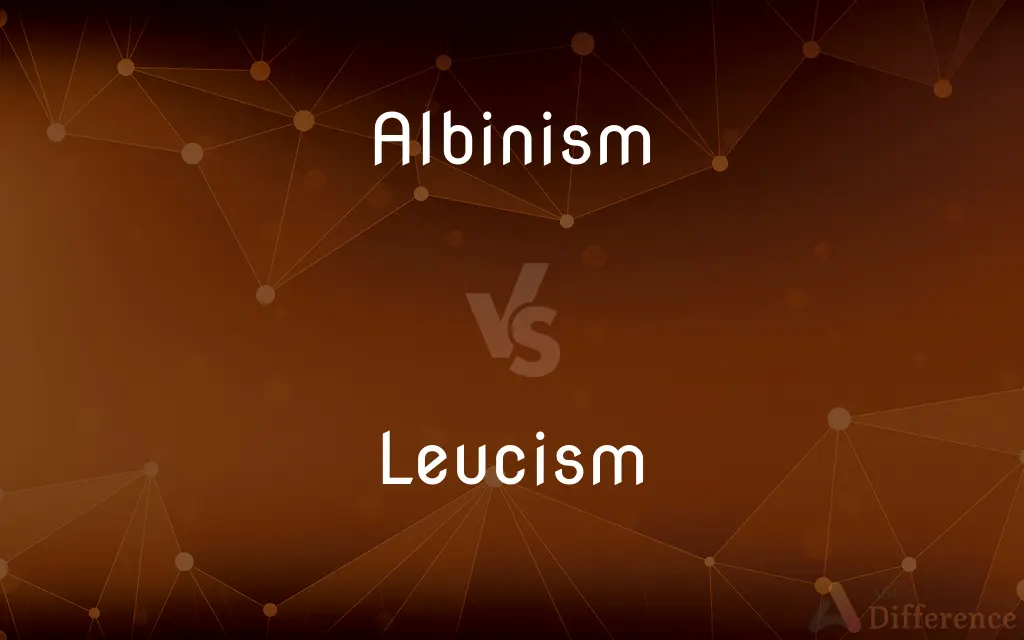Albinism vs. Leucism — What's the Difference?
By Tayyaba Rehman — Published on January 31, 2024
Albinism is a genetic condition causing a lack of melanin pigment, resulting in white hair, skin, and pink eyes. Leucism is a partial loss of pigmentation affecting skin, hair, or feathers, but not eyes.

Difference Between Albinism and Leucism
Table of Contents
ADVERTISEMENT
Key Differences
Albinism is a genetic condition where there is an absence of melanin, the pigment that gives color to skin, hair, and eyes, leading to a characteristic appearance of white or pale skin and hair, and pink or light blue eyes. In contrast, leucism is characterized by a partial reduction in pigmentation, which primarily affects the skin, hair, or feathers of an individual, but unlike albinism, it does not affect eye color, leaving the eyes their natural color.
Individuals with albinism often face sensitivity to sunlight due to the lack of melanin, which provides some protection against UV radiation. This contrasts with leucism, where the partial loss of pigmentation does not typically result in increased sensitivity to sunlight. The underlying genetic causes of albinism are different from those of leucism, highlighting the distinct nature of these conditions.
Albinism is often associated with certain vision problems, including visual acuity issues and nystagmus, due to the lack of pigment in the retina. Leucism, on the other hand, does not typically result in vision problems, as the condition does not affect the pigmentation of the eyes or the retina. This highlights a significant difference in the impact of these two conditions on vision.
In albinism, the lack of pigmentation is uniform across the entire body, leading to a consistent pale appearance in all pigmented tissues. In contrast, leucism can result in patchy or uneven loss of pigmentation, leading to a more varied appearance with patches of normal coloring mixed with areas of reduced pigmentation.
In terms of occurrence, both albinism and leucism can be found across various species, including humans, mammals, birds, and reptiles. However, albinism is generally rarer than leucism and is strictly inherited, whereas leucism can occur sporadically and may not follow a clear inheritance pattern.
ADVERTISEMENT
Comparison Chart
Pigmentation Affected
Complete lack of melanin in skin, hair, eyes
Partial loss of pigmentation, not affecting eyes
Vision Impact
Often associated with vision problems
Does not typically affect vision
Sensitivity to Sunlight
Increased sensitivity due to lack of melanin
Normal sensitivity to sunlight
Appearance
Uniformly pale skin and hair, pink or light blue eyes
Patchy or uneven loss of pigmentation, normal eye color
Genetic Inheritance
Strictly inherited genetic condition
Can be inherited or occur sporadically
Compare with Definitions
Albinism
Albinism can cause vision problems like reduced visual acuity and nystagmus.
Special accommodations were made at school for the student's albinism-related vision issues.
Leucism
Leucism affects skin, hair, or feathers, but does not change eye color.
Despite its white feathers, the bird's eyes were the usual dark color, indicating leucism.
Albinism
Albinism affects individuals across various species, not just humans.
The albino peacock in the zoo was a rare and striking sight.
Leucism
Leucism can result in patchy or uneven pigmentation.
The deer exhibited leucism with its irregular white patches.
Albinism
Albinism results in pale skin, white hair, and pink or light blue eyes.
The child with albinism required extra sun protection due to sensitive skin.
Leucism
Leucism is a condition characterized by partial loss of pigmentation.
The leucistic lion had patches of white in its otherwise tawny coat.
Albinism
Albinism is a genetic condition marked by the complete absence of melanin pigment.
The albino rabbit had pure white fur and pink eyes.
Leucism
Leucism can be inherited or occur sporadically.
The leucistic traits in the family of swans suggested a genetic link.
Albinism
Any of several inherited conditions characterized by the reduction or absence of the pigment melanin in a person or animal, resulting in lack of pigmentation in the eyes, skin, and hair. Humans with albinism usually have vision problems.
Leucism
Leucism is different from albinism, as it does not affect vision or sensitivity to sunlight.
The leucistic snake had normal vision, unlike albino counterparts.
Albinism
Lack of chlorophyll in a plant or plant part, resulting in a pale color.
Leucism
A partial loss of pigmentation in a human or other animal, resulting in white, pale, or patchy coloration of the skin, hair, fur, or feathers but not the eyes.
Albinism
Congenital lack of melanin pigmentation in the skin, eyes, and hair or feathers (or more rarely only in the eyes); the condition of being albino.
Leucism
An animal condition in which there is partial loss of pigmentation resulting in white, pale, or patchy coloration of the skin, hair, feathers, scales or cuticle, but not the eyes (caused by a reduction in multiple types of pigment, not just melanin).
Albinism
The state or condition of being an albino: abinoism; leucopathy.
Albinism
The congenital absence of pigmentation in the eyes and skin and hair
Albinism
Albinism is inherited through specific genetic mutations.
Genetic testing confirmed the diagnosis of albinism in the newborn.
Common Curiosities
How is albinism inherited?
Albinism is inherited through specific genetic mutations passed from parents to offspring.
What is leucism?
Leucism is a partial loss of pigmentation that affects skin, hair, or feathers but not the eyes.
Can leucism be inherited?
Leucism can be inherited or occur sporadically, without a clear genetic pattern.
What is albinism?
Albinism is a genetic condition causing a complete lack of melanin pigment in the skin, hair, and eyes.
What color are the eyes in albinism?
Eyes in albinism are typically pink or light blue due to the lack of pigmentation.
How is albinism diagnosed?
Albinism is diagnosed based on physical characteristics and genetic testing.
Do individuals with albinism have vision problems?
Yes, albinism is often associated with vision problems like reduced visual acuity and nystagmus.
Is leucism common in wildlife?
Leucism is relatively more common in wildlife compared to albinism.
Can leucism result in uneven pigmentation?
Yes, leucism can lead to patchy or uneven loss of pigmentation.
Does leucism cause sensitivity to sunlight?
No, leucism does not cause increased sensitivity to sunlight.
What color are the eyes in leucism?
In leucism, the eyes retain their normal color as eye pigmentation is not affected.
Does leucism affect vision?
No, leucism does not typically affect vision as it does not involve pigmentation of the eyes.
Can albinism occur in animals?
Yes, albinism can occur in various species including mammals, birds, and reptiles.
Are albino individuals sensitive to sunlight?
Yes, individuals with albinism are more sensitive to sunlight due to the lack of melanin.
Are there any health concerns associated with leucism?
Leucism itself does not typically cause health issues, unlike albinism which can include vision problems and sensitivity to sunlight.
Share Your Discovery

Previous Comparison
1D Array vs. 2D Array
Next Comparison
British Empire vs. CommonwealthAuthor Spotlight
Written by
Tayyaba RehmanTayyaba Rehman is a distinguished writer, currently serving as a primary contributor to askdifference.com. As a researcher in semantics and etymology, Tayyaba's passion for the complexity of languages and their distinctions has found a perfect home on the platform. Tayyaba delves into the intricacies of language, distinguishing between commonly confused words and phrases, thereby providing clarity for readers worldwide.
















































